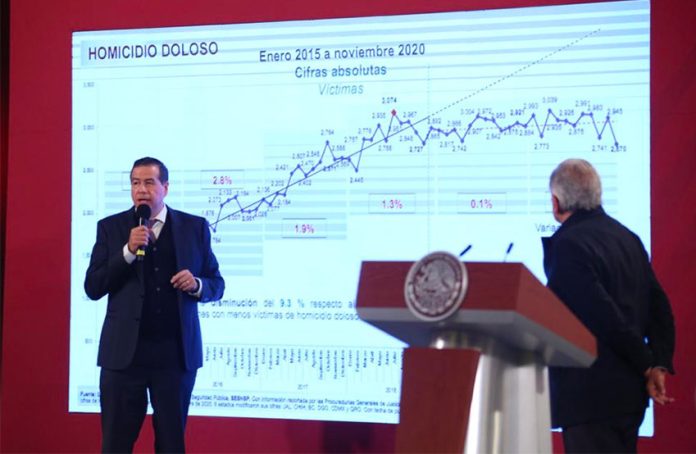There were fewer homicides in November than in any other month since President López Obrador took office in December 2018 but 2020 still remains on track to surpass 2019 as the most violent year on record.
Deputy Security Minister Ricardo Mejía said Friday that there were 2,670 homicides last month, a 9.3% decline compared to October.
Mexico’s homicide tally for the first 11 months of the year is 31,871, an increase of 0.9% compared to the same period of 2019.
If the average monthly number of homicides – 2,897 – is recorded in December, 2020 will go down as the most violent year ever with almost 35,000 murders. There were more than 34,500 homicides last year.
More than half of the homicides between January and November – 52% – occurred in just six states. Guanajuato was the most violent followed by Baja California, México state, Chihuahua, Jalisco and Michoacán.
Mejía said that 27.5% of the homicides occurred in 15 highly violent municipalities. They are:
- Tijuana, Baja California;
- Ciudad Juárez, Chihuahua;
- León, Guanajuato;
- Celaya, Guanajuato;
- Culiacán, Sinaloa;
- Cajeme, Sonora;
- Zamora, Michoacán;
- Guadalajara, Jalisco;
- Acapulco, Guerrero;
- Chihuahua;
- Benito Juárez (Cancún), Quintana Roo;
- Irapuato, Guanajuato;
- Ensenada, Baja California;
- Salamanca, Guanajuato; and
- Morelia, Michoacán.
The deputy minister said that a new security strategy will be implemented in those municipalities.
“On the instructions of the president a specific program will start up in these municipalities, … a comprehensive strategy for the reduction of homicides,” Mejía said.
“There will be permanent monitoring by the [federal] security cabinet and the president has instructed that security cabinet meetings presided over by him be held in each of these 15 municipalities over the course of next year.”
Specific actions of the new strategy include providing additional support to local governments, investigating links between organized crime and rehabilitation centers – where numerous homicides have occurred, increasing police patrols in the most violent neighborhoods, dismantling extortion networks, training police and launching more social programs.
“[The strategy] will have a bearing on the fight against drug trafficking … and take down extortion,” Mejía said. “… In accordance with the instructions of the president, intelligence actions and police training will be strengthened.”
López Obrador took office in late 2018 pledging to restore peace to Mexico and gradually withdraw the armed forces from the nation’s streets. But violence has worsened on his watch and he continues to rely heavily on the military for public security tasks.
In addition to homicides, femicides – the killing of women and girls on account of their gender – have also increased this year.
There were 888 femicides in the first 11 months of the year, a 1.7% increase compared to the same period of 2019. There were 85 femicides in November, up 2.2% from October.
México state, Veracruz, Mexico City and Nuevo León recorded the highest number of femicides while on a per capita basis Colima and Morelos are at the head of the list of the most violent states for women.
Federal organized crime offenses increased 46.7% between January and November compared to the same period of last year, while domestic violence rose 4.4%.
Mejía highlighted that the incidence of a range of other crimes has decreased this year.
Among them: fuel theft, down 45.3%; financial crimes, down 32.5%; drug trafficking, down 7.3%; kidnapping, down 37.2%; vehicle theft, down 24.6%; burglaries, down 23.1%; extortion, down 7.8%; rape, down 5.5%; and robbery of businesses, down 19.6%.
